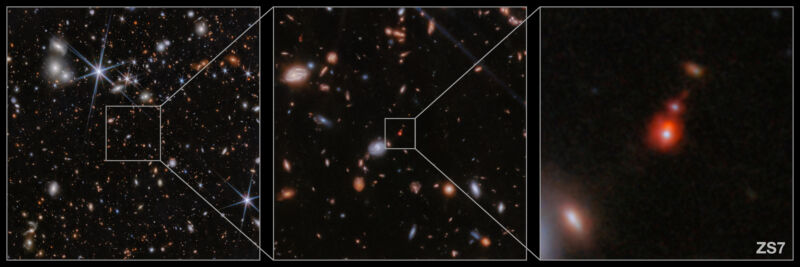
Supermassive black holes appear to reside at the center of every galaxy and to have done so since galaxies formed early in the history of the Universe. Currently, however, we can't entirely explain their existence, since it's difficult to understand how they could grow quickly enough to reach the cutoff for supermassive as quickly as they did.
A possible bit of evidence was recently found by using about 20 years of data from the Hubble Space Telescope. The data comes from a globular cluster of stars that's thought to be the remains of a dwarf galaxy and shows that a group of stars near the cluster's core are moving so fast that they should have been ejected from it entirely. That implies that something massive is keeping them there, which the researchers argue is a rare intermediate-mass black hole, weighing in at over 8,000 times the mass of the Sun.
Moving fast
The fast-moving stars reside in Omega Centauri, the largest globular cluster in the Milky Way. With an estimated 10 million stars, it's a crowded environment, but observations are aided by its relative proximity, at "only" 17,000 light-years away. Those observations have been hinting that there might be a central black hole within the globular cluster, but the evidence has not been decisive.
The new work, done by a large international team, used over 500 images of Omega Centauri, taken by the Hubble Space Telescope over the course of 20 years. This allowed them to track the motion of stars within the cluster, allowing an estimate of their speed relative to the cluster's center of mass. While this has been done previously, the most recent data allowed an update that reduced the uncertainty in the stars' velocity.
Within the update data, a number of stars near the cluster's center stood out for their extreme velocities: seven of them were moving fast enough that the gravitational pull of the cluster isn't enough to keep them there. All seven should have been lost from the cluster within 1,000 years, although the uncertainties remained large for two of them. Based on the size of the cluster, there shouldn't even be a single foreground star between the Hubble and the Omega Cluster, so these really seem to be within the cluster despite their velocity.
The simplest explanation for that is that there's an additional mass holding them in place. That could potentially be several massive objects, but the close proximity of all these stars to the center of the cluster favor a single, compact object. Which means a black hole.
Based on the velocities, the researchers estimate that the object has a mass of at least 8,200 times that of the Sun. A couple of stars appear to be accelerating; if that holds up based on further observations, it would indicate that the black hole is over 20,000 solar masses. That places it firmly within black hole territory, though smaller than supermassive black holes, which are viewed as those with roughly a million solar masses or more. And it's considerably larger than you'd expect from black holes formed through the death of a star, which aren't expected to be much larger than 100 times the Sun's mass.
This places it in the category of intermediate-mass black holes, of which there are only a handful of potential sightings, none of them universally accepted. So, this is a significant finding if for no other reason than it may be the least controversial spotting of an intermediate-mass black hole yet.
What’s this telling us?
For now, there are still considerable uncertainties in some of the details here—but prospects for improving the situation exist. Observations with the Webb Space Telescope could potentially pick up the faint emissions from gas that's falling into the black hole. And it can track the seven stars identified here. Its spectrographs could also potentially pick up the red and blue shifts in light caused by the star's motion. Its location at a considerable distance from Hubble could also provide a more detailed three-dimensional picture of Omega Centauri's central structure.
Figuring this out could potentially tell us more about how black holes grow to supermassive scales. Earlier potential sightings of intermediate-mass black holes have also come in globular clusters, which may suggest that they're a general feature of large gatherings of stars.
But Omega Centauri differs from many other globular clusters, which often contain large populations of stars that all formed at roughly the same time, suggesting the clusters formed from a single giant cloud of materials. Omega Centauri has stars with a broad range of ages, which is one of the reasons why people think it's the remains of a dwarf galaxy that was sucked into the Milky Way.
If that's the case, then its central black hole is an analog of the supermassive black holes found in actual dwarf galaxies—which raises the question of why it's only intermediate-mass. Did something about its interactions with the Milky Way interfere with the black hole's growth?
And, in the end, none of this sheds light on how any black hole grows to be so much more massive than any star it could conceivably have formed from. Getting a better sense of this black hole's history could provide more perspective on some questions that are currently vexing astronomers.
Nature, 2024. DOI: 10.1038/s41586-024-07511-z (About DOIs).



3175x175(CURRENT).thumb.jpg.b05acc060982b36f5891ba728e6d953c.jpg)
Recommended Comments
There are no comments to display.
Join the conversation
You can post now and register later. If you have an account, sign in now to post with your account.
Note: Your post will require moderator approval before it will be visible.